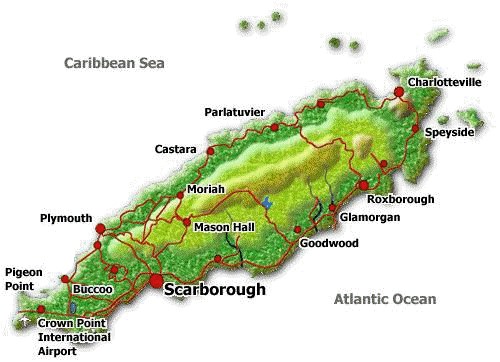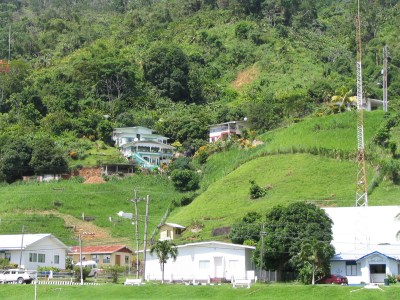 Map of Tobago
Map of Tobago
TriniView.com Reporters
November 17, 2006
Charlotteville is the last village along the Windward Road and is situated on the northeasternmost tip of Tobago. It lies west of the Man-of-War Bay which has great historical significance in the country and is skirted by a wall of high mountains.
Charlotteville is known for its scenic view overlooking land and sea from high hills and its tranquility in natural surroundings. It is also surrounded by rain forests which adds to the magnificence of the area.
Tobago, like the other islands of the Caribbean, is steeped in a history of European conquest and enslavement. In fact, the small island had changed hands as many as 22 times by the European colonizers, which is more often than any other West Indian island. The first European settlers in the area arrived circa 1633, and the second batch arrived in 1639.
As a result, the village of Charlotteville was directly influenced by this history of imperialism and colonialism.
Within the village existed several agricultural estates which were fairly profitable during the epoch of enslavement. The villagers during this time were involved in sugar cultivation, and later on, during the period of 1916-1918, began experimenting with banana which was a rising success as well as cocoa for commercial purposes, which proved a successful venture for the agriculturalists. By 1946, according to the census reports of that year, the area had a total of 277 households and as many as 1,360 people including some Grenadians who came to Tobago, possibly due to the shortage of agricultural labour during the war (WWII).
 View of the hills from Riverside Stadium
View of the hills from Riverside Stadium
Also significant in the creation of the village of Charlotteville as we know it today was the acquirement of the Pirates' Bay Estates and Charlotteville Estate in 1865 by the Turpin family who combined them into one holding of approximately 11,000 acres.
What many today may not realize is that the village of Charlotteville was not always accessible by land. It is in this regard that the Man-of-War Bay was so significant because it allowed for the transportation of food, machinery and humans. Because of its natural deep-water seaport, large vessels were able to dock in the area. In addition, the deep bay allowed for fishing which is another activity that Charlotteville is popular for. However, by the 1930s the Man-of-War Bay became less significant as a coastal port with the construction of an overland route.
Despite the difficulties of accessing the Charlotteville village by land, some still managed to set foot through the thick forest and undulating hills via footpaths created by people, which is the same path that the main road follows today.
One of the famous landmarks still in existence in Charlotteville is Fort Cambelton which was built by the British to safeguard the Charlotteville settlement by way of the Man-of-War Bay.
In current times, Charlotteville is still one of the leading fishing ports in the country. However, because of 'Hurricane Flora' 1963, agriculture has suffered tremendously and many gave up on the practice. Still, banana production managed to be continued in the area and approximately 4,000 pounds of bananas leave Charlotteville for the main town of Scarborough for sale and export.
Today, there are two schools in the village, a police station and a few churches. There are no large hotels but only a few small guesthouses for tourists to enjoy.
Also popular in Charlotteville are guided tours and hikes through the rainforest, the oldest protected rainforest in the western hemisphere and which is still visibly scarred by Hurricane Flora. Little Tobago is only a few miles away from the coast and is a popular site for bird watching and other explorations.
Charlotteville also has small tamboo bamboo bands (the rhythms are produced by pounding bamboo on the earth) which had originated during the era of enslavement when Africans were debarred from playing their traditional musical instruments.
Sunbathing and snorkeling in Pirates Bay are also very popular activities that people enjoy when they venture to Charlotteville. Hopefully though, Charlotteville would remain a serene place that can be enjoyed for its simple and natural beauty.
Tobago in pictures
Tobago| Homepage | Carnival Features | Special Events
|
